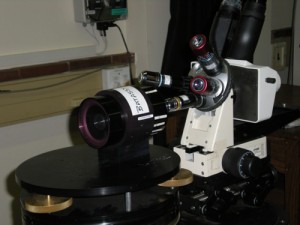 The situational awareness and threat identification afforded with surveillance cameras, night vision devices and infrared cameras, depend on the quality of images produced by these sensors. Performance deterioration occurs during normal use, storage or from abuse. The Optronic Test and Evaluation Laboratory looks at the effects of the deterioration, for example.
The situational awareness and threat identification afforded with surveillance cameras, night vision devices and infrared cameras, depend on the quality of images produced by these sensors. Performance deterioration occurs during normal use, storage or from abuse. The Optronic Test and Evaluation Laboratory looks at the effects of the deterioration, for example.
The capabilities include testing and evaluation of lens, and/or camera systems for image quality by performing the following tests:
Day and/or night resolution tests
The purpose of this test is to determine the smallest pattern (highest spatial frequency) that can be seen by a lens or camera or system. The finer the pattern that can be seen by a lens or camera or system, the better the performance. The result provides objective values that can be used in specification support, smart buyer / decision support, acceptance testing and selection of usable legacy equipment.
Modulation transfer function testing
To use the result it is necessary to define what task the end-user of a lens has in mind for it, for example to identify a number plate, a particular camouflaged vehicle, etc. Then it is necessary to establish what levels of modulation at specific spatial frequencies are required in order to perform the test. If the system is capable of delivering these levels of modulation, then the task is possible, otherwise not. The result provides objective values that can be used, e.g. in specification support, smart buyer / decision support, and acceptance.
Minimum resolvable temperature difference testing
Infrared cameras are useful in military applications, because they can “see” the heat emitted by everything , e.g. body heat of humans, heat from engines of vehicles, ships and aircraft, and the environment. Tests exist for characterising the performance of infrared cameras. It is the equivalent blackbody temperature difference between a standard target at a given spatial frequency and its background, such that the target is “just resolved” by an observer.
Camera non-uniformity characterisation using an integrating sphere source
The purpose of this source is to generate a uniform radiance for a hyper-spectral camera. It is used for satellite image calibration and camera uniformity characterisation.
Thermal effects using an incubator:
The behaviour and performance of optronic sensors, cameras and lenses depends on the temperature at which it operates, which is affected, e.g. by ambient temperature. The OTE laboratory is equipped with an environmental chamber
Certain of the laboratory’s testing capabilities are ISO/IEC 17025 accredited by the South African National Accreditation System (SANAS).
dpss@csir.co.za
